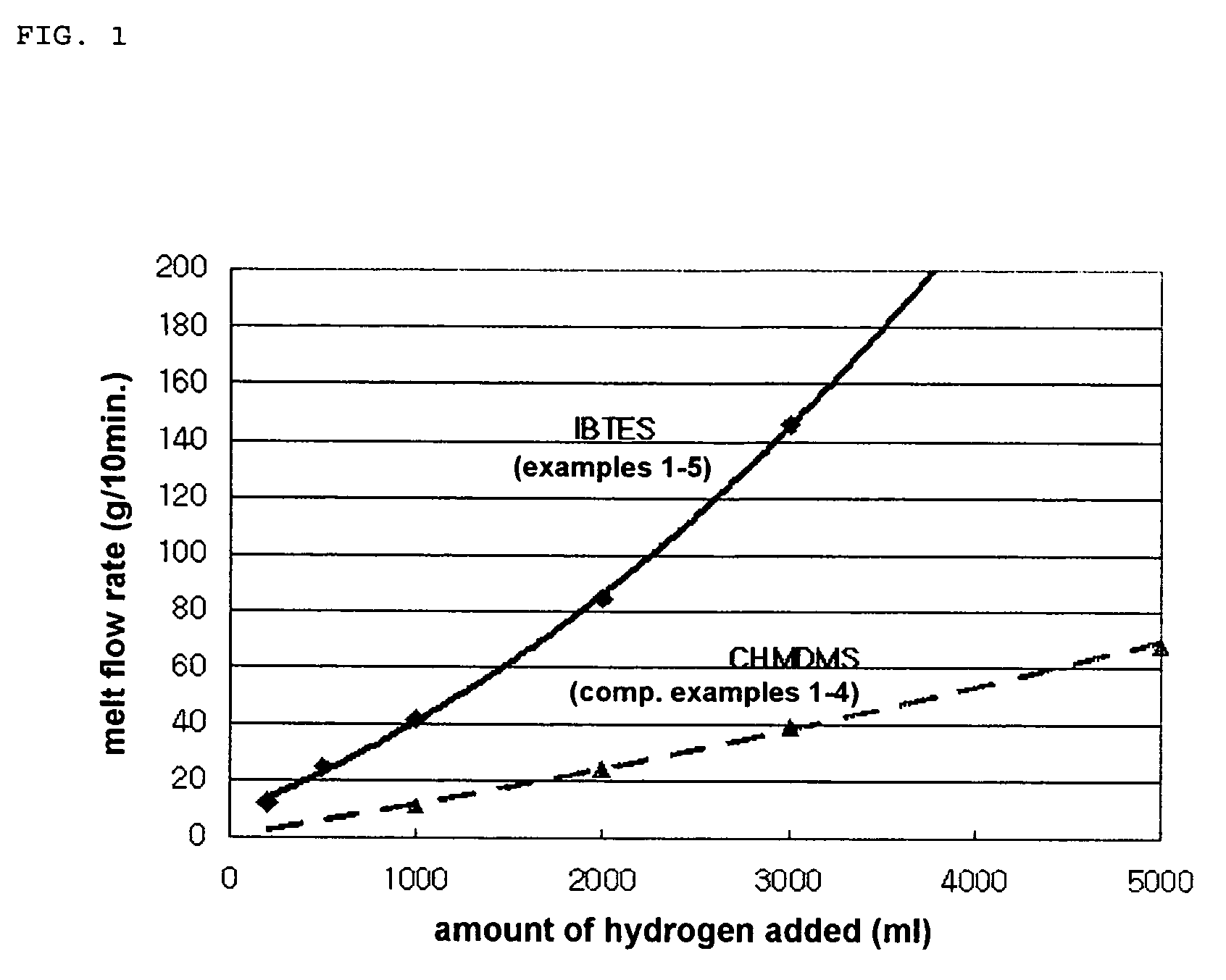Method for producing propylene polymer having a very high melt-flowability
a propylene polymer and melt flow technology, which is applied in the field of producing propylene polymers with a very can solve the problems of insufficient reactivity of a molecular weight controlling agent such as hydrogen, significant decrease in hydrogen reactivity, and insufficient hydrogen reactivity to achieve polypropylene having a melt flow rate of 50 g/10 minutes or more in practical, etc., to achieve high melt flow rate, high isotactic index, and high production yield ratio ratio ratio ratio ratio ratio ratio ratio ratio ratio ratio ratio ratio ratio ratio ratio ratio ratio ratio ratio ratio ratio ratio ratio ratio ratio ratio ratio ratio ratio ratio ratio ratio ratio ratio ratio ratio ratio ratio ratio ratio ratio ratio ratio ratio ratio ratio ratio ratio ratio ratio ratio ratio ratio ratio ratio ratio ratio ratio ratio ratio ratio ratio ratio ratio ratio ratio ratio ratio ratio ratio ratio ratio ratio ratio ratio ratio ratio ratio ratio ratio ratio ratio ratio ratio ratio ratio ratio ratio ratio ratio ratio ratio ratio ratio ratio ratio ratio ratio ratio ratio ratio ratio ratio ratio ratio ratio ratio ratio ratio ratio ratio ratio ratio ratio ratio ratio ratio ratio ratio ratio ratio ratio ratio ratio ratio ratio ratio ratio ratio ratio ratio ratio ratio ratio ratio ratio ratio ratio ratio ratio ratio ratio ratio ratio ratio ratio ratio ratio ratio ratio ratio ratio ratio ratio ratio ratio ratio ratio ratio ratio ratio ratio ratio ratio ratio ratio ratio ratio ratio ratio ratio ratio ratio ratio ratio ratio ratio ratio ratio ratio ratio ratio ratio ratio ratio ratio ratio ratio ratio ratio ratio ratio ratio ratio ratio ratio ratio ratio ratio ratio ratio ratio ratio ratio ratio ratio ratio ratio ratio ratio ratio ratio ratio ratio ratio ratio ratio ratio ratio ratio ratio ratio ratio ratio ratio ratio ratio ratio ratio ratio ratio ratio ratio ratio ratio ratio ratio ratio ratio ratio ratio ratio ratio ratio ratio ratio ratio ratio ratio ratio ratio ratio ratio ratio ratio ratio ratio ratio ratio ratio ratio ratio ratio ratio ratio ratio ratio ratio ratio ratio ratio ratio ratio ratio ratio ratio ratio ratio ratio ratio ratio ratio ratio ratio ratio ratio ratio ratio ratio ratio ratio ratio ratio ratio ratio ratio ratio ratio ratio ratio ratio ratio ratio ratio ratio ratio ratio ratio ratio ratio ratio ratio ratio ratio ratio ratio ratio ratio ratio ratio ratio ratio ratio ratio ratio ratio ratio ratio ratio ratio ratio ratio ratio ratio ratio ratio ratio ratio ratio ratio ratio ratio ratio ratio ratio ratio ratio ratio ratio ratio ratio ratio ratio ratio ratio ratio ratio ratio ratio ratio ratio ratio ratio ratio ratio ratio ratio ratio ratio ratio ratio ratio ratio ratio ratio ratio ratio ratio ratio ratio ratio ratio ratio ratio ratio ratio ratio ratio ratio ratio ratio ratio ratio
- Summary
- Abstract
- Description
- Claims
- Application Information
AI Technical Summary
Benefits of technology
Problems solved by technology
Method used
Image
Examples
example 1
[Preparation of Main Catalyst Component]
[0025]To a 1L glass reactor equipped with stirrer which has been sufficiently substituted with nitrogen, 200 ml of toluene and diethoxy magnesium (25 g, 0.219 mol) were added and stirred at 250 rpm while maintaining the temperature at 10° C. 75 ml of titanium tetrachloride was added thereto over 30 minutes, and then, the temperature of the reactor was elevated to 110° C. at the speed of 0.5° C. per minute, and during the temperature elevation, 7.5 ml of diisobutyl phthalate (DIBP) (0.028 mol) was further added when the temperature was reached to 25° C. The resulted mixture was allowed to react at 110° C. for 1 hour with stirring, and then remained still without stirring so that solid products may settle down. The supernatant liquid was removed therefrom and the precipitates were washed by adding 250 ml of fresh toluene and stirring for 15 minutes. The same washing procedure was repeated once more.
[0026]To the resulted solid product, 200 ml of ...
examples [UNK]
EXAMPLES 22˜28
[0063]A propylene polymer was prepared by using the same main catalyst and cocatalyst components and the same method as in Example 1 above, but in the [propylene polymerization] step,[0064]0.55 mmol of IBTES+0.15 mmol of dicyclopentyldimethoxysilane (DCPDMS),[0065]0.45 mmol of IBTES+0.25 mmol of DCPDMS,[0066]0.35 mmol of IBTES+0.35 mmol of DCPDMS,[0067]0.25 mmol of IBTES+0.45 mmol of DCPDMS,[0068]0.15 mmol of IBTES+0.55 mmol of DCPDMS,[0069]0.35 mmol of IPTES+0.35 mmol of DCPDMS and[0070]0.35 mmol of NBTES+0.35 mmol of DCPDMS
were used respectively as external electron donor, instead of 0.7 mmol of isobutyltriethoxysilane (IBTES) in Example 1.
[0071]With the obtained respective propylene polymer, polymerization activity, isotactic index, melt flow rate and melting point thereof were determined by the same method as in Example 1 above, and the results were represented in Table 2 below.
PUM
| Property | Measurement | Unit |
|---|---|---|
| isotactic index | aaaaa | aaaaa |
| isotactic index | aaaaa | aaaaa |
| isotactic index | aaaaa | aaaaa |
Abstract
Description
Claims
Application Information
 Login to View More
Login to View More - R&D
- Intellectual Property
- Life Sciences
- Materials
- Tech Scout
- Unparalleled Data Quality
- Higher Quality Content
- 60% Fewer Hallucinations
Browse by: Latest US Patents, China's latest patents, Technical Efficacy Thesaurus, Application Domain, Technology Topic, Popular Technical Reports.
© 2025 PatSnap. All rights reserved.Legal|Privacy policy|Modern Slavery Act Transparency Statement|Sitemap|About US| Contact US: help@patsnap.com

